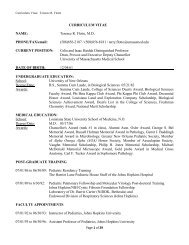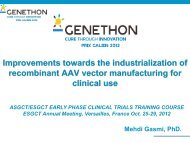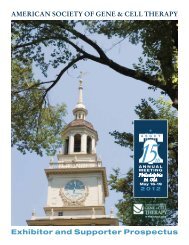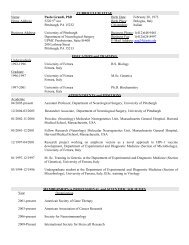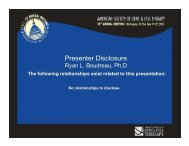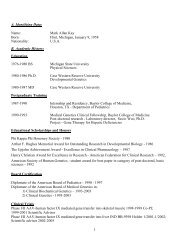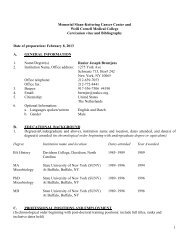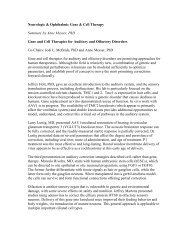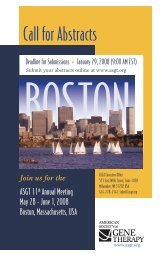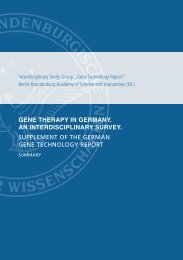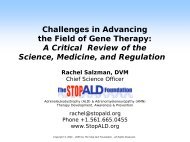FINAL PROGRAM - American Society of Gene & Cell Therapy
FINAL PROGRAM - American Society of Gene & Cell Therapy
FINAL PROGRAM - American Society of Gene & Cell Therapy
- No tags were found...
Create successful ePaper yourself
Turn your PDF publications into a flip-book with our unique Google optimized e-Paper software.
13 th AnnUAL MEETing | Washington, DC USA May 19-22, 2010 63Program SchedulePresidential Symposium 330 — continuedJean Bennett, MD, PhDAn Aye for <strong>Gene</strong> <strong>Therapy</strong>: Lessons from a Clinical Trial for Congenital Blindness<strong>Gene</strong> therapy has the potential to reverse disease or prevent further deterioration <strong>of</strong> vision in patients with incurable inherited retinal degeneration. The recent demonstration<strong>of</strong> safe and stable recovery <strong>of</strong> retinal/visual function in 12 children and adults with Leber’s congenital amaurosis (LCA) due to RPE65 mutations in a trialbeing carried out at The Children’s Hospital <strong>of</strong> Philadelphia (CHOP), and encouraging results from two other clinical trials for LCA-RPE65 provide great hope for peoplewith other more common blinding diseases. This presentation will describe the latest safety and efficacy results in the LCA-RPE65 clinical trial being held at CHOP. Thisstudy is now >2.5 years past initiation. In addition, it will describe some <strong>of</strong> the challenges presented by the nature <strong>of</strong> the targeted disease itself, hurdles that havebeen navigated in order to conduct the study, and issues <strong>of</strong> importance for eventual approval <strong>of</strong> gene augmentation as a therapy for LCA and other blinding diseases.*This presentation involves contributions from the following additional individuals (listed alphabetically): Carmen Acerra, Defne Amado, Alberto Auricchio, SandroBanfi, Jeannette Bennicelli, Erin Bote, Yifeng Chen, Daniel Chung, Ann Fulton, Jeffrey Golden, Rebecca Grant, Bernd Hauck, Daniel Hui, Katherine A. High, BartLeRoy, Arkady Lyubarsky, Albert M. Maguire, Maureen G. Maguire, Kathleen Marshall, Federico Mingozzi, Jessica Morgan, Kristina Narfstrom, Stephen Orlin, EricA. Pierce, Settimio Rossi, Kenneth S. Shindler, Francesca Simonelli, Enrico M. Surace, Edwin Stone, Junwei Sun, Nasreen Syed, Francesco Testa, Nicholas J. Volpe,Jennifer Wellman, J. Fraser Wright, Gui-shuang Ying, Olga Zelenaia, Xiaosong (Sonia) ZhuFriday, May 21 stDavid A. Williams, MDNew Approaches to <strong>Gene</strong> <strong>Therapy</strong> for Fanconi AnemiaFA is a rare recessive syndrome characterized by bone marrow failure, congenital anomalies and a predisposition to malignancy. FA cells have a defect in DNA repairthat leads to increased spontaneous chromosomal breakage. Transgenic expression <strong>of</strong> FA genes in vitro corrects the increased chromosomal breakage and othercellular phenotypes <strong>of</strong> the disease. In a recent gene therapy trial, we have demonstrated that gene transfer per se is no longer a limitation to the effectiveness <strong>of</strong>gene therapy in this disease. Rather our clinical studies show that even early in the disease process there are significant deficiencies in the number and/or function<strong>of</strong> hematopoietic stem cells (HSCs) that can be collected and utilized as targets in gene transfer. One approach that could address this deficiency is the derivation<strong>of</strong> HSC from induced pluripotent stem (iPS) cells reprogrammed from non-blood somatic tissues. Important advantages <strong>of</strong> iPS cells for application <strong>of</strong> gene therapyare the apparent unlimited proliferative capacity <strong>of</strong> such cells (allowing production <strong>of</strong> large numbers <strong>of</strong> derived HSC) and the ability to clone such cells allowing bothsingle cell correction <strong>of</strong> genetic mutations and prospective molecular characterization <strong>of</strong> manipulated cells prior to therapeutic applications.



